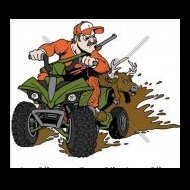-
Posts
3,925 -
Joined
-
Last visited
-
Days Won
208
Content Type
Profiles
Forum
Gallery
ATV Magazine
Events Calendar
Downloads
Store
Community Map
Posts posted by Frank Angerano
-
-
Accidentally got the right one!! I would never be so lucky!
Keep us posted on how it works out.
-
@Scott M agreed 100%
-
 1
1
-
-
Wow!! I knew it, jumped. That chain looks fu****. I would double check the chain is free of any more kinks like the one you see and if any links are not moving well then replace it.
Hopefully no damage to the piston or valves!!!!! Its a long shot but hopefully none.
-
Wow! Looks like an atv thats been on the beach! A lot!!
-
They kept saying it was going to shut down and we never received any official notice until today. We are to make the work areas safe close up shop and shut down by Friday afternoon.
-
It all sounds logical and i agree with the valve slop being a possibility, a valve seal coming off will cause the fouled plugs. As far as compression goes i have a feeling it's a lot worse then valve slop and maybe a bent valve or something along those lines.
-
We are hearing the city may get shut down by Wednesday. If so i will head upstate to do a little riding.
-
-
I have a friend that has the same atv. He keeps it running tip top. So far its still running strong.
-
Couple of ways to look at this.
Double check timing straight away. When you reassemble the top end did you set the timing correctly? Ive done it before and found it 180 degrees out BUT I always slowly rotate the the engine without the spark plug in and feel for any hits between the valves and piston. So if you went ahead and cranked it right out of the gate and timing was off then you could have a cracked piston or bent valve. (worst case)
So pull the valve cover off and get to TDC compression stroke and look at your timing, also look at your chain tensioner and make sure you put it all back right and that it had not allowed the chain to jump and cause the above possible damage.
Have you checked your head gaskets and did you use quality gaskets?? Cheap head gaskets go bad real quick especially if there is a slight warp in the head.
Valves: did you put the valves back where they came from? Each valve if using old valves should go back exactly where they came from. Valve seals, its possible one has come off?
Pull the spark plug wire off after you have confirmed the timing is right and crank the engine and listen for air leaks. Spray windex on the top end and look for bubbles if you want. Spray around the head gaskets, loosen the oil fill cap and spray around that as well while cranking. If you get bubbles then there is compression leaking into the crank case.
-
Nice work and great job explaining the test results. Keep us posted!
-
Ok lets go through some steps and do a process of elimination thing.
If your concerned or think its the carburetor then go through the manual, check the spec on the jets and the sizes and make sure everything is proper according to the specifications including the float height. Check the choke and make sure its not getting hung up or pulled in while the throttle is reving ? This way you will rule out the carburetor.
Next would be fuel flow from the tank. Could be restricted or have some sort of vapor lock from the gas cap? Leave the cap off and see if it still gives you a problemAfter that i would look at the intake boot that connects the carburetor to engine and check for any cracks that may be sucking in air from time to time. A simple trick to test this is spray some carburetor cleaner around the carburetor while the engine is running and listen for any changes in the way the engine runs, lightly wiggle the carburetor as well to expose any cracks on the boot
So after all this is done you will have ruled out any carburetor and fuel delivery issues.
If that has not fixed the problem i would buy an in line spark tester and attach it to the spark plug and spark plug wire and see if the spark breaks down under a throttle load. Its about $10 bucks on Amazon.
Get a tester and start to check the specs on all of the electrical equipment, regulator, stator etc. Even if you replaced them or tested to it again. Rule out all items electrically and write down everything.
While the engine is running start wiggling the wire harness around and again listen for changes.
After that the only thing it could be is tye cdi$$$$$$$$$ And that sucks!!!
-
Have you checked the gap on the pick up coil? I remember a post way back about a similar problem and it turns out the gap on the pick up coil was the problem. It ran great in place but after a load was put on it the atv it bogged down.
-
Was the new carburetor an oem or a cheap replacement? China carburetor?
-
Honestly heres my take. If its at the point where you feel its bad and a possibility that the tank my have skunk gas as well then pull the tank and clean the carburetor and tank properly. I've very rarely had luck by rotating and cleaning the carburetor in place. You only wind up pulling it all out again.
-
 1
1
-
-
You don't have to take the tank off. Sometimes it makes life easier but it should be able to come off without taking the tank off. I like to loosen both clamps first. Disconnect the gas lone, pull the carb out so you can take the throttle cable and the choke cable off. Re assemble in the same way.
-
Your very welcome!
-
Yep seen that. They has an outside booth set up in tye back but I guess maybe people weren't showing up?
-
Hey @Meg Sam welcome to Quadcrazy.
I don't think that atv has reverse.
Here is a website that may have what your looking for.
https://www.ud-spareparts.com/Spare-parts-ATV-Bashan-Bashan-Parts-ATV-250cc-BS250S11-c-1535_564.html
-
Good way to distance yourself!!
Ride safe. -
The regulator can cause these symptoms and easy enough to test or cheap enough to replace.
The magnets have been known to move on the flywheels the only reason I'm agreeing with you about it NOT being your problem is the fact that you state it runs fine until hot. In my case it would run like sh** right out of the gate. Your pick up coil could also be the problem when hot. Get your tester and check the spec book on it. Then go ahead and test the coil when its cold and then when the engine gets hot or starts to act up to see if the numbers are the same.
-
-
I just recently went through a similar problem on my Suzuki Eiger.
Turns out it was my flywheel. My magnet configuration was off.
The image you posted is called a cdi box. The cdi is what gets and tells the spark/ignition when to fire. The pick up/trigger coil (located by the stator coil) gets its signal from the flywheel which has a small metal tab on it that passes by the pickup/trigger coil. When is passes by the coil sends a signal to the cdi and that cdi delivers spark to the ignition coil.
In some instances the cdi fails when the diodes or the small capacitors inside go bad and the electrical current that's meant to flow in one one direction no longer does that and creates a haywire flow of current.
If its a capacitor that goes bad inside it usually kills the cdi completely (no spark) when a diode goes bad it allows current to go in either direction and that is where you get the misfire.
unfortunately there is no way to test or repair the cdi box and its an expensive part to gamble on.
Back to the flywheel, the magnets have a glue that holds them in place. That glue has failed on a run for about 3 or 4 years of the artic cat and Suzuki engines. This allows the magnets to move around and cause havoc on the ignition system. The way to inspect this is to pull the side cover off and inspect the flywheel magnets.
Start with the flywheel and go from there.
Then inspect the cdi for any moisture or cracks/damage. It should be located in the rear under the plastics by the storage compartment.-
 1
1
-
-
That is crazy! Great info brother.







2004 Recon No Compression
in Honda ATV Forum
Posted
That sucks but have you found out why this happened? One would have to hope it was just a locked up chain.
The only way to test the piston, valves etc for compression would be you have to fill that cylinder head with air pressure and see how it holds. Even if you have to rig an air compressor hose to the fitting from your leak down gauges that goes into the spark plug hole and set it to 90 psi and fill the head up.